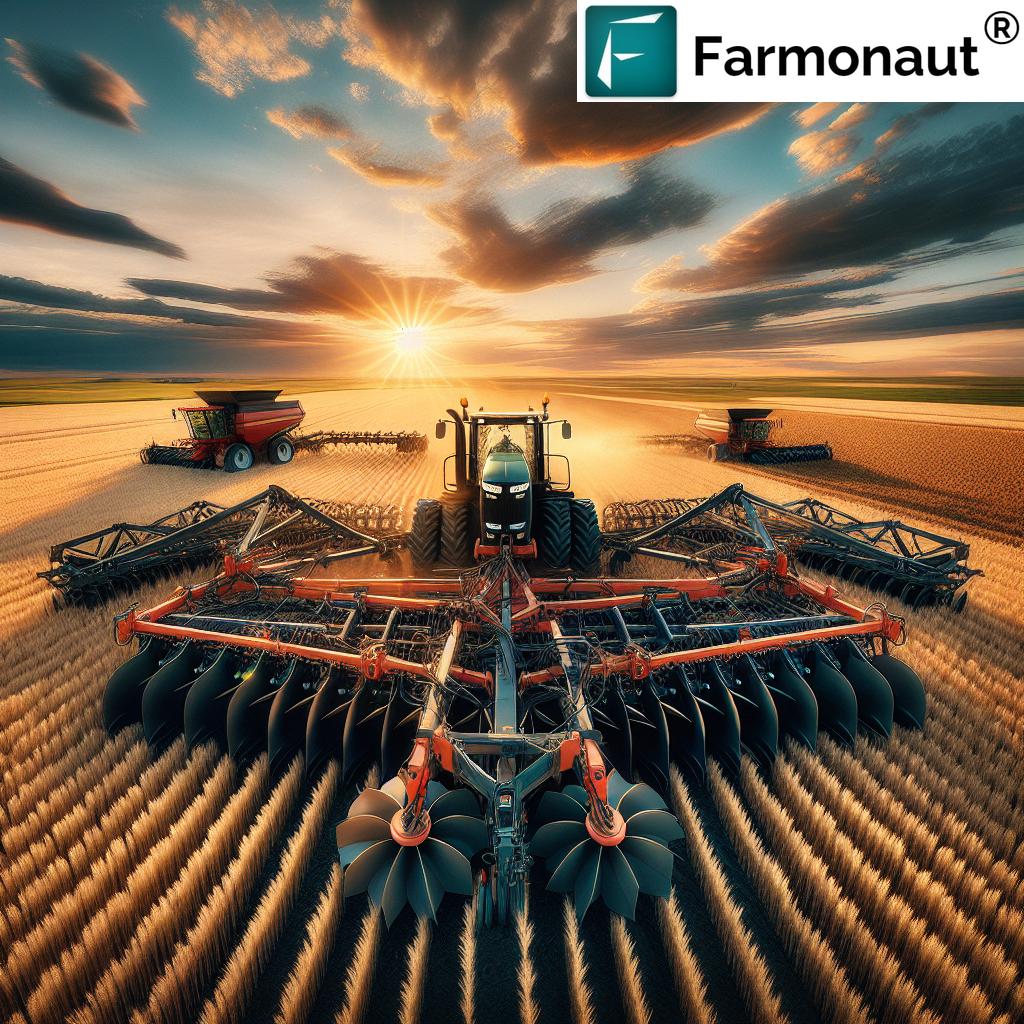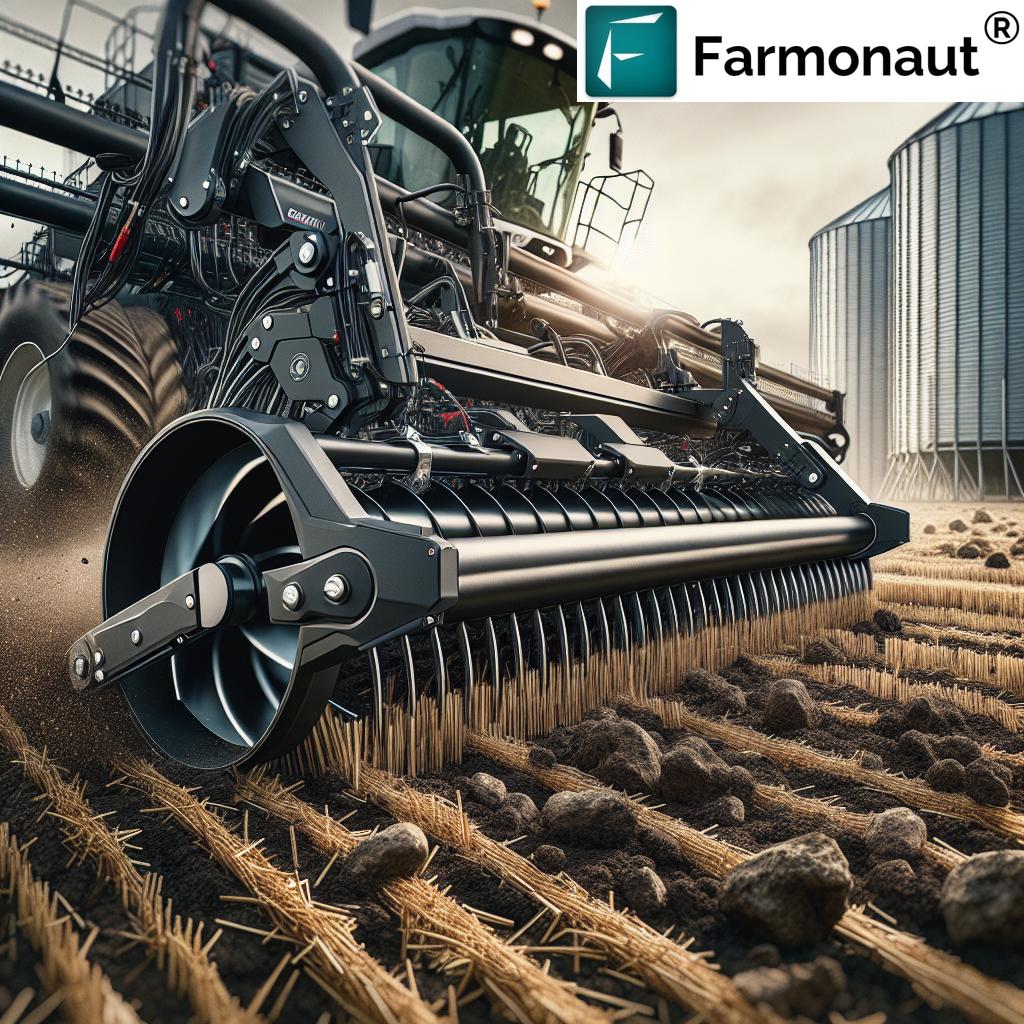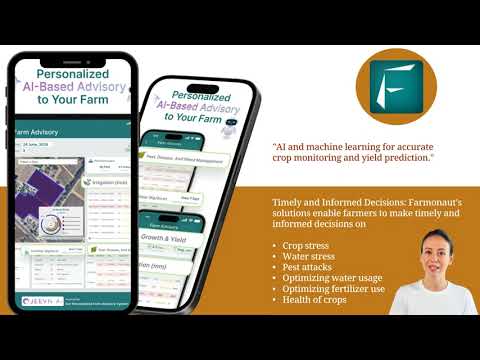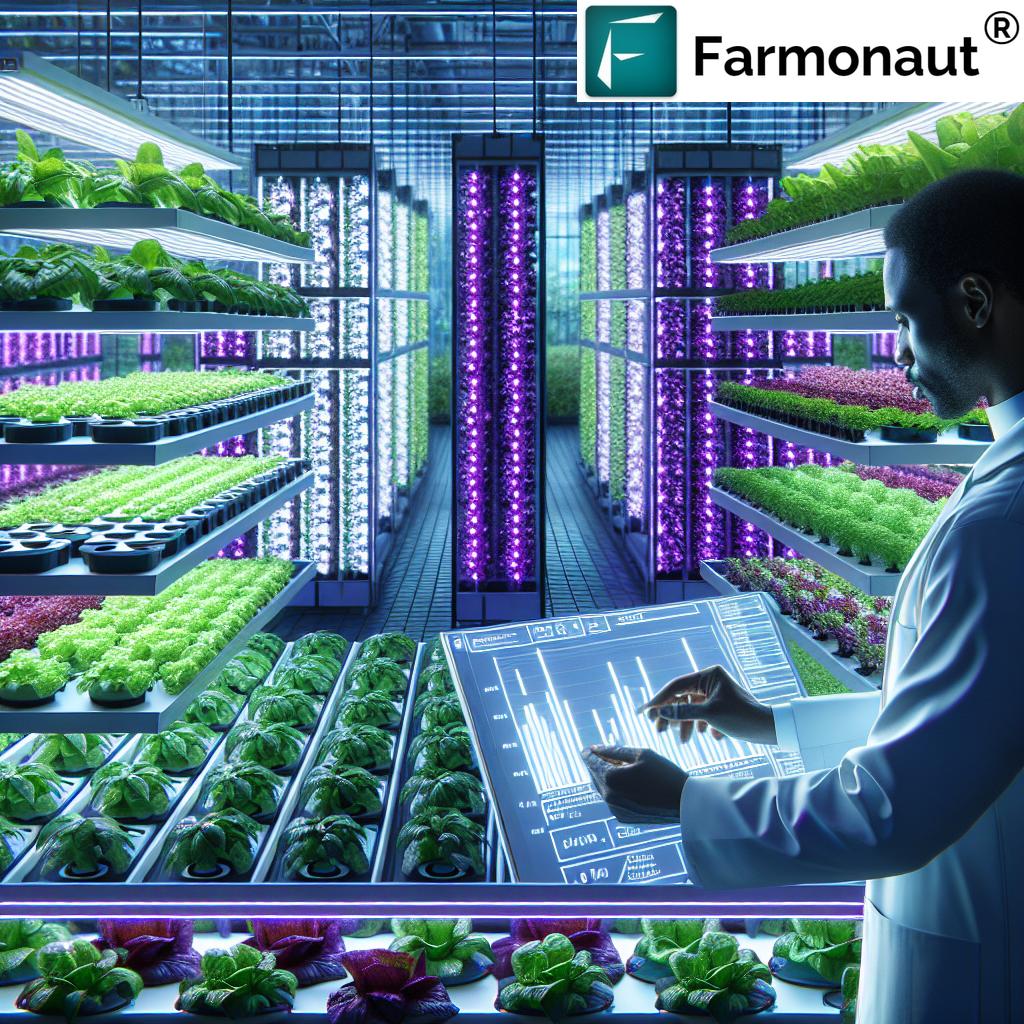Revolutionizing Agriculture: Cutting-Edge Farm Equipment Trends for Efficient Soil Preparation in Saskatchewan
In the heart of Canada’s prairies, Saskatchewan farmers are embracing a new era of agricultural innovation. As we at Farmonaut continue to pioneer satellite-based farm management solutions, we’re excited to explore the cutting-edge trends in farm equipment that are transforming soil preparation practices across the province. From advanced tillage systems to state-of-the-art manure spreaders, the agricultural landscape is evolving rapidly, promising increased efficiency and sustainability for farmers of all scales.

“Saskatchewan farmers using advanced manure spreaders can increase organic fertilizer application efficiency by up to 30%.”
The Evolution of Tillage Equipment in Saskatchewan
Tillage equipment has come a long way from the traditional plow. Today’s agricultural machinery in Saskatchewan incorporates precision technology and innovative design to optimize soil preparation. Let’s delve into some of the most impactful advancements:
- Pro-Till Series: These versatile machines combine the benefits of vertical tillage with the efficiency of high-speed discs. They’re designed to handle heavy residue while maintaining an even soil profile.
- Staggered Rippers: Advanced ripper designs now feature staggered tines that break up compaction layers without bringing excess subsoil to the surface, preserving topsoil integrity.
- Precision Depth Control: Modern tillage equipment often includes hydraulic depth control systems that ensure consistent working depth across varying field conditions.
These innovations in tillage equipment for crop management are not just about turning soil; they’re about creating the optimal environment for seed germination and root development. By incorporating technologies like GPS guidance and variable-rate applications, Saskatchewan farmers can tailor their tillage practices to specific field areas, reducing energy consumption and minimizing soil disturbance.
Heavy-Duty Harrows: Redefining Seedbed Preparation
Heavy-duty harrows have become indispensable tools for Saskatchewan farmers looking to create the perfect seedbed. These robust implements offer several advantages:
- Versatility: Modern harrows can be used for multiple purposes, from breaking up clods to incorporating fertilizer and leveling fields.
- Adjustable Tine Pressure: Operators can fine-tune the aggressiveness of the harrow to match varying soil conditions across their fields.
- Wide Working Widths: Many new models offer expansive working widths, allowing farmers to cover more ground in less time.
The evolution of heavy harrows has led to the development of multi-functional tools like the strawmaster. These implements excel at distributing crop residue evenly across the field, which is crucial for no-till and conservation tillage systems popular in Saskatchewan.
Land Rollers: Enhancing Seed-to-Soil Contact
Land rollers for farming have gained popularity among Saskatchewan farmers for their ability to improve seed-to-soil contact and create a level playing field, literally. Here’s why they’re becoming a staple in modern farm equipment fleets:
- Improved Germination: By pressing seeds firmly into the soil, land rollers enhance germination rates and promote even crop emergence.
- Moisture Conservation: Rolling helps seal in soil moisture, which is particularly beneficial in Saskatchewan’s semi-arid climate.
- Stone Management: In rocky areas, rollers can push surface stones into the soil, reducing equipment damage during subsequent operations.
The latest land rollers feature innovations like single drum designs that offer better maneuverability and reduced soil disturbance. Some models even incorporate hydraulic weight transfer systems to maintain consistent pressure across the entire working width.
Rock Removal Equipment: Clearing the Way for Productivity
In Saskatchewan’s diverse terrain, rock removal equipment plays a crucial role in preparing fields for cultivation. Modern rock pickers and diggers have evolved to meet the challenges of efficient stone management:
- Automated Rock Pickers: These machines use sophisticated sensors to detect and collect rocks of various sizes without operator intervention.
- Rock Diggers with Integrated Rakes: Combining digging and raking functions, these implements can unearth and collect deeply embedded rocks in a single pass.
- High-Capacity Rock Buckets: Designed for use with front-end loaders or skid steers, these buckets efficiently separate rocks from soil, speeding up the clearing process.
The integration of rock removal technology with GPS mapping systems allows farmers to create detailed maps of rock-prone areas, enabling targeted removal strategies and long-term field improvement planning.

Manure Spreaders: Precision in Organic Fertilization
As Saskatchewan farmers increasingly turn to organic fertilizers, manure spreaders for organic fertilizers have undergone significant technological advancements:
- Precision Application Systems: Modern spreaders use variable-rate technology to adjust application rates on-the-go, ensuring optimal nutrient distribution.
- Vertical Beater Designs: These systems provide more even spreading patterns and can handle a variety of manure consistencies.
- Real-Time Nutrient Sensing: Some advanced models incorporate sensors that analyze manure composition in real-time, allowing for precise nutrient management.
These innovations in manure spreaders not only improve fertilizer efficiency but also contribute to environmental stewardship by reducing the risk of nutrient runoff.
“Modern rotary cutters in Saskatchewan can clear vegetation 50% faster than traditional methods, boosting overall farm productivity.”
Straw Management Machinery: Turning Residue into Resource
Straw management machinery has become increasingly important in Saskatchewan’s no-till and conservation tillage systems. These implements help farmers make the most of crop residues:
- High-Speed Straw Choppers: Integrated into combine harvesters, these choppers finely cut and evenly distribute straw across the field width.
- Bale Processors: For livestock operations, modern bale processors can efficiently spread straw for bedding or feed, reducing labor and improving animal comfort.
- Residue Management Attachments: These add-ons for tillage equipment help incorporate straw into the soil, accelerating decomposition and nutrient cycling.
Effective straw management not only improves soil health but also plays a crucial role in pest and disease management by reducing overwintering sites for pathogens.
Rotary Cutters: Versatile Vegetation Management
Rotary cutters for vegetation management have evolved from simple mowing tools to sophisticated land management implements. In Saskatchewan, where diverse landscapes require flexible solutions, modern rotary cutters offer:
- Multi-Spindle Designs: These provide wider cutting widths and more even distribution of cut material.
- Hydraulic Wing Folding: For easy transportation between fields and improved maneuverability.
- Adjustable Cutting Heights: Allowing farmers to tailor vegetation management to specific crop or pasture needs.
Some advanced rotary cutter models now feature sidearm attachments, enabling operators to manage vegetation in hard-to-reach areas like ditches and fence lines efficiently.
Innovative Hitches and Attachments
The way implements connect to tractors has also seen significant innovation. The scorpion hitch, for example, represents a leap forward in implement control and efficiency:
- Improved Maneuverability: Scorpion hitches allow for tighter turns and better tracking on contours.
- Weight Distribution: They help optimize the distribution of implement weight, reducing soil compaction.
- Multi-Implement Capability: Some designs allow farmers to pull multiple implements in a single pass, increasing efficiency.
These advanced hitching systems are particularly valuable in Saskatchewan’s varied terrain, where flexibility and precision in implement control can significantly impact productivity.
The Role of Technology in Modern Farm Equipment
While we at Farmonaut focus on satellite-based farm management solutions, it’s important to recognize how technology is being integrated into physical farm equipment:
- IoT Sensors: Modern implements often feature sensors that collect real-time data on soil conditions, implement performance, and application rates.
- Telematics: Equipment can now transmit operational data to cloud-based platforms, allowing farmers to monitor and optimize their fleet’s performance remotely.
- AI-Powered Decision Support: Some advanced systems use artificial intelligence to provide real-time recommendations for equipment settings based on current field conditions.
These technological advancements complement our satellite-based crop monitoring services, providing farmers with a comprehensive view of their operations from space to soil.
Sustainability and Efficiency: The Dual Focus of Modern Farm Equipment
As Saskatchewan farmers face increasing pressure to produce more while reducing their environmental impact, modern farm equipment is evolving to meet these dual challenges:
- Fuel Efficiency: New engine technologies and aerodynamic designs are reducing fuel consumption across all equipment types.
- Precision Application: Variable-rate technology in spreaders, sprayers, and seeders minimizes input waste and optimizes resource use.
- Soil Health Preservation: Low-disturbance implements help maintain soil structure and reduce erosion risks.
These advancements align with our mission at Farmonaut to promote sustainable farming practices through data-driven insights and precision agriculture techniques.
Choosing the Right Equipment for Your Saskatchewan Farm
Selecting the appropriate farm equipment for your operation involves careful consideration of several factors:
- Farm Size and Terrain: Larger operations may benefit from wider implements, while hilly or irregular fields might require more maneuverable equipment.
- Soil Type: Saskatchewan’s varied soil types, from heavy clay to sandy loam, influence the choice of tillage and seeding equipment.
- Crop Rotation: Your planned crop rotation affects the type of residue management and soil preparation tools you’ll need.
- Conservation Goals: If you’re practicing conservation tillage or no-till farming, look for equipment designed to minimize soil disturbance.
Remember, the most advanced equipment is only as effective as the management practices behind it. That’s where our satellite-based monitoring and AI advisory systems can provide valuable insights to optimize your equipment use and overall farm management strategy.
The Future of Farm Equipment in Saskatchewan
Looking ahead, we anticipate several exciting developments in farm equipment technology:
- Autonomous Implements: Self-driving tractors and implements that can operate 24/7, optimizing field operations.
- Electric and Hybrid Power: As battery technology improves, we expect to see more electric and hybrid farm equipment, reducing emissions and operating costs.
- Swarm Technology: Smaller, interconnected machines working together to perform tasks more efficiently than large, single units.
- Biodegradable Materials: Implements made from environmentally friendly materials that reduce the environmental impact of equipment manufacturing and disposal.
These innovations will work hand-in-hand with advanced farm management platforms like Farmonaut, creating a more connected and efficient agricultural ecosystem.
Comparison of Modern Farm Equipment for Soil Preparation in Saskatchewan
| Equipment Type | Key Features | Efficiency Improvement | Best Suited For |
|---|---|---|---|
| Tillage Equipment | Precision depth control, GPS guidance, variable-rate technology | Up to 25% increase in soil preparation efficiency | Large-scale grain farms, heavy soil types |
| Heavy-Duty Harrows | Adjustable tine pressure, wide working widths, multi-functional capabilities | 20-30% improvement in seedbed preparation time | Medium to large farms, varied soil conditions |
| Land Rollers | Single drum designs, hydraulic weight transfer systems | 15-20% increase in seed germination rates | All farm sizes, especially beneficial for pulse crops |
| Manure Spreaders | Precision application systems, real-time nutrient sensing | Up to 30% increase in fertilizer application efficiency | Organic farms, livestock operations |
| Straw Management Machinery | High-speed choppers, residue management attachments | 25-35% improvement in residue decomposition rates | No-till and conservation tillage systems |
| Rotary Cutters | Multi-spindle designs, hydraulic wing folding, adjustable cutting heights | 40-50% faster vegetation clearing | Diverse landscapes, pasture management |
Integrating Farm Equipment with Satellite-Based Management
At Farmonaut, we understand the importance of integrating advanced farm equipment with cutting-edge farm management technologies. Our satellite-based monitoring services complement modern machinery by providing:
- Precision Guidance: Our high-resolution satellite imagery can be used to create accurate field maps for precision equipment guidance.
- Variable Rate Application Maps: By analyzing crop health data from satellite imagery, we generate variable-rate application maps that can be directly uploaded to compatible farm equipment.
- Equipment Efficiency Tracking: Our platform can help track and analyze equipment usage patterns, identifying opportunities for improved efficiency.
By combining the power of satellite technology with advanced farm equipment, Saskatchewan farmers can achieve new levels of productivity and sustainability.
To experience how Farmonaut can enhance your farm management practices, consider exploring our platform:
For those interested in integrating our satellite data directly into their systems, check out our API:
Developers can find comprehensive documentation here:
Our mobile apps are also available for on-the-go farm management:
Frequently Asked Questions
- Q: How do modern tillage equipment improve soil health?
A: Modern tillage equipment uses precision technology to minimize soil disturbance while effectively managing residue. This helps preserve soil structure, reduce erosion, and promote beneficial microbial activity. - Q: Are electric farm implements viable for large Saskatchewan farms?
A: While electric farm implements are still emerging, they show promise for reducing operational costs and emissions. As battery technology improves, we expect to see more viable electric options for large-scale operations in Saskatchewan. - Q: How can satellite-based farm management improve equipment efficiency?
A: Satellite-based systems like Farmonaut provide detailed field data that can be used to optimize equipment routes, adjust application rates, and identify areas requiring specific attention, leading to more efficient use of farm machinery. - Q: What are the benefits of using rotary cutters with sidearm attachments?
A: Rotary cutters with sidearm attachments offer greater flexibility in managing vegetation in hard-to-reach areas like ditches and fence lines. They improve efficiency by allowing operators to cover more ground without changing equipment. - Q: How do modern manure spreaders contribute to sustainable farming practices?
A: Advanced manure spreaders use precision application technology to ensure optimal nutrient distribution, reducing the risk of over-application and nutrient runoff. This leads to more efficient use of organic fertilizers and better environmental stewardship.
Conclusion
The landscape of farm equipment in Saskatchewan is evolving rapidly, with innovations aimed at improving efficiency, sustainability, and productivity. From advanced tillage systems to precision manure spreaders, these technologies are helping farmers meet the challenges of modern agriculture. At Farmonaut, we’re excited to be part of this agricultural revolution, providing satellite-based insights that complement and enhance the capabilities of cutting-edge farm equipment.
As we look to the future, the integration of advanced machinery with data-driven farm management practices will be key to ensuring the continued success and sustainability of Saskatchewan’s agricultural sector. By embracing these innovations and combining them with platforms like Farmonaut, farmers can optimize their operations, reduce environmental impact, and increase yields, securing a prosperous future for agriculture in the prairies and beyond.




















